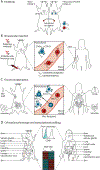Location, location, location: Tissue resident memory T cells in mice and humans
- PMID: 30952804
- PMCID: PMC6778482
- DOI: 10.1126/sciimmunol.aas9673
Location, location, location: Tissue resident memory T cells in mice and humans
Abstract
The discovery of T cells resident in diverse tissues has altered our understanding of adaptive immunity to encompass site-specific responses mediated by tissue-adapted memory T cells throughout the body. Here, we discuss the key phenotypic, transcriptional, and functional features of these tissue-resident memory T cells (TRM) as established in mouse models of infection and translated to humans by novel tissue sampling approaches. Integration of findings from mouse and human studies may hold the key to unlocking the potential of TRM for promoting tissue immunity and preventing infection.
Copyright © 2019 The Authors, some rights reserved; exclusive licensee American Association for the Advancement of Science. No claim to original U.S. Government Works.
Figures


References
-
- Sallusto F, Lenig D, Forster R, Lipp M, Lanzavecchia A, Two subsets of memory T lymphocytes with distinct homing potentials and effector functions. Nature 401, 708–712 (1999). - PubMed
-
- Masopust D, Vezys V, Marzo AL, Lefrancois L, Preferential localization of effector memory cells in nonlymphoid tissue. Science 291, 2413–2417. (2001). - PubMed
-
- Reinhardt RL, Khoruts A, Merica R, Zell T, Jenkins MK, Visualizing the generation of memory CD4 T cells in the whole body. Nature 410, 101–105. (2001). - PubMed
-
- Wakim LM, Waithman J, van Rooijen N, Heath WR, Carbone FR, Dendritic cell-induced memory T cell activation in nonlymphoid tissues. Science 319, 198–202 (2008). - PubMed
-
- Gebhardt T et al., Memory T cells in nonlymphoid tissue that provide enhanced local immunity during infection with herpes simplex virus. Nat Immunol 10, 524–530 (2009). - PubMed
Publication types
MeSH terms
Grants and funding
LinkOut - more resources
Full Text Sources
Other Literature Sources

